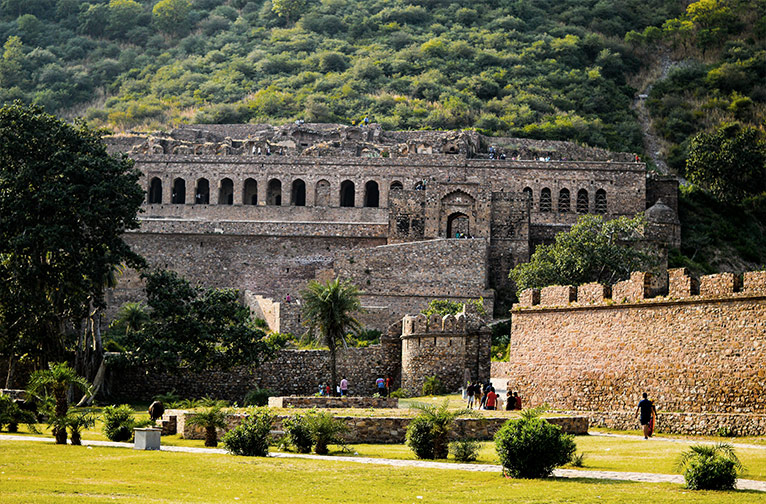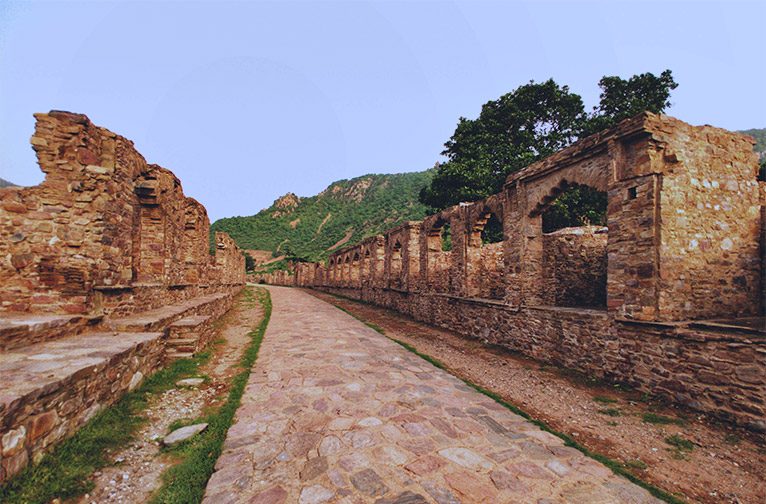State capital Jaipur is perfectly positioned as a base for exploring some of Rajasthan’s most alluring destinations as well as some lesser visited gems on a day trip.
Ranthambore National Park
A 3.5-hr drive from Jaipur transports you to one of India’s most renowned National Parks, featured in glossy wildlife brochure itineraries, for its tiger-spotting opportunities.
Ranthambore National Park, home to the tiger, the apex predator of the Indian jungles, once made world headlines for the exploits of the world’s most photographed tigress—Macchli. Though she has now passed on to happier hunting grounds, Macchli was famed for her hunting skills and immense courage in taking on, and killing, a 12-foot-long fully adult mugger crocodile. The mugger crocodile, which can also walk on land, is an apex predator in freshwater ecosystems. Tigers rarely take on these wily beasts whom you will encounter often sunning themselves near water bodies in the park.
Jeep safaris through the Ranthambhore National Park, located in the Sawai Madhopur district, offer excellent opportunities for enjoying viewings of its wildlife as well as its amazing botanical wealth. Amongst the other attractions in the park is Padam Talao, its biggest waterbody and a huge draw for a wealth of avifauna. This also makes Ranthambhore a favoured spot for birding enthusiasts. This lotus filled pond is also a good spot for sightings of wildlife, especially during the summer months.
The Jogi Mahal, the old royal hunting lodge nestled by its serene waters, has a lovely atmospheric vibe to it. Within its precincts stands India’s second largest banyan tree. No longer in use now, Jogi Mahal falls along the trail to Ranthambore Fort where the Trinetra Ganesh Temple is located. The Ganesh shrine is a living temple visited regularly for worship by the local community.
Between the Padam Lake and Raj Bagh Lake you’ll also come upon the Raj Bagh ruins, a cavalcade of palace outhouses, domes and arches dating to bygone eras veiled behind the tentacles of the jungle.
If you have the time, you should visit the Rajiv Gandhi Regional Museum of Natural History located in Ramsinghpura village, 9 km from the Sawai Madhopur. You can explore the offerings of Dastkar Ranthambore, an NGO initiative to resettle the local rural communities in the area. You can shop for variety of handcrafted, eco-friendly products on sale here. The Ranthambore School of Art, located quite close to the Sawai Madhopur railway station, is a magnet for art lovers. The initiative focuses on creating greater awareness for the conservation of wildlife and biodiversity of the region.
Sambhar Salt Lake
The recently concluded Sambhar Lake Festival put the spotlight on one of Rajasthan’s most unique geographic settings. While Gujarat state has the much-touted Rann of Kutch and its vast moonscape of salt pans, Rajasthan has been quietly showcasing the lesser discovered charms of its salty marshlands as defined by the otherworldly setting of Sambar Salt Lake, a 2-hr drive from Jaipur city.
It may surprise travellers to learn that Sambhar Lake is the largest saline lake in India. Spread over three districts— Jaipur, Ajmer, and Nagaur, this massive saline wetland with its salt pans, shallow water bodies, and semi-arid scrubland, is a huge draw for domestic as well as migratory birds.
Also, one of India’s important Ramsar Wetlands, the 90 sq km Sambhar Salt Lake is big enticement during the annual arrival of the Greater and Lesser flamingos amongst the other migratory water birds from the East Asian, Central Asian, and East African flyways. Boat rides can take you close to some of the favoured spots of these winter visitors on the lake. You can also joy train rides through this unique terrain.
Sambhar has played a very important role in India’s salt mining industry from olden times. You can see the still in-use British-era Circuit House here. During the annual festival, held here in winter to coincide with the migratory period of the flamingos, visitors enjoy a range of activities including ATC rides, hot air ballooning and cultural programmes.
Other spots to visit are the 6th century Shakambari Devi Temple, the Devyani Temple and Kund and the archaeological site of Naliasar. Sambhar town itself has ancient links to the Mahabharata and served as an important source for salt for the Rajputs, Marathas, Mughals and British, till Rajasthan state took over the salt production in 1949. It's interesting to note that the Mughal Emperor Akbar is said to have married the Rajput princess Jodha Bai here. Sambhar has also served as a filming venue for Hindi movies like Ramleela, Kai Po Che, PK etc.
Bhangarh
Considered to be one of India’s most haunted places, Bhangarh continues to hold a big allure for intrepid adventurers and history buffs. Located just two hours away from Jaipur, this abandoned town since the 18th century is worth exploring for its rich atmospherics and legends of hauntings.
Nestling along the outskirts of Sariska National Park Bhangarh was once a flourishing hub for Amber’s Kachwaha rulers, ever since it was built by Raja Bhagwat Singh for his son Madho Singh in 1537. Madho Singh was succeeded by Raja Bhagwat Singh, whose son was the famous general of Emperor Akbar, Man Singh. It was during the rule of Man Singh's son Chhattar Singh that things started going sideways for Bhangarh.


It appears that a local tantric, Singhia Sevra, fell in love with Chhattar Singh’s beautiful daughter, Ratnavati. But when she rejected his advances, he went into a deep fury but he was determined to have her. He decided to administer a love potion in a bottle of oil purchased by her maid in the bazaar, with the hope that the princess would fall madly in love with him. But the princess, alert to the sage's evil designs, having questioned her servant, took the bottle and smashed it against a rock. The boulder started moving and gathering force crushed the tantric who was nearby. In his last moments Singhia Sevra cursed her and Bhangarh's citizens. Things started going badly for Bhangarh a year later with the battle between Bhangarh and Ajabgarh, in which the princess lost her life. The citizenry soon abandoned Bhangarh's cursed soil leaving it to dwindle away…a plaything of the elements, as it is even today.
Visitors in the day find sun-dappled ruins of the marketplace, temples, havelis, a wind-blown palace and large tank. At the far end lies the shell of the palace said to be haunted by weird sounds and blood curdling shrieks late at night. Only four bat- and- spirits infested floors remain of the original elegant 7-storied structure. Local lore has it that the only safe places after dark are the Someshwar, Hanuman, Ganesh, Vishal Devta, Lavina Devi, and Keshav Rai temples.
The gates of Bhangarh are firmly shut after sunset by order of the ASI, which has officially disallowed people from entering the site till sunrise on the following day.
Jaipur offers visitors a slew of compelling reasons to expand your explorations with easy driving distance for a variety of holiday experiences. With a bit of homework and advance planning you can have the time of your life on these jaunts.